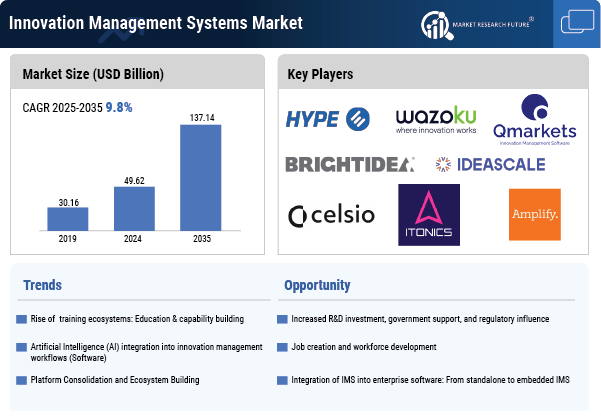Based on Region, the global Innovation management systems is segmented into North America, Europe, Asia-Pacific, Middle East & Africa, and South America. Asia-Pacific accounted for the largest market share in 2024 and is anticipated to reach USD 19.45 Billion by 2035. Asia-Pacific is projected to grow at the highest CAGR of 10.7% during the forecast period. VC investments, patent activity, innovation clusters, research institution, number of companies having documented innovation policies, number of companies adopting software for innovation management, all these factors influence the market size of innovation management systems.
Asia-Pacific's (APAC's) role in globalization is evolving from low-cost manufacturing and resource exports to leadership in innovation, culture and investment. This is due to several economical, social and technological factors of the region. Innovation in APAC is driven by rising R&D investment and growing patent activity. R&D spending in South Korea, Japan and China exceeds that of Europe as a share of GDP. China is the second largest country in the world with high GERD ( Gross Expenditure on Research and Development) for many years. Asia Pacific accounts for more than 35% of global R&D.
In 2024, China reported over 1 million invention patent grants and saw its companies file a record number of patent applications at the European Patent Office (EPO) and the Patent Cooperation Treaty (PCT), placing China as the leading global source for PCT applications. China's National Intellectual Property Administration (CNIPA) announced over 1 million invention patent grants in 2024, an increase of about 13.5% from the previous year. Asia now accounts for 55% of all listed companies globally and 27% of total global market capitalisation. This remarkable growth has positioned Asia as one of the most important regions in global capital markets. China has the largest number of listed domestic companies and is also a significant source of global companies. Large number of organizations, high economical value, high spend intensity and high cultural acceptance makes the region with the largest market share.
Apart from China, Japan has holds world-class research and several global innovation clusters, but its corporate culture is still more traditional and incremental, focusing on continuous improvement (Kaizen) rather than radical innovation. Asia-Pacific reflects a dual picture: Northeast Asia and Singapore show strong alignment with structured innovation management principles, with practices that echo ISO 56001 frameworks, while India and Australia are in transition, building process maturity but still marked by fragmented or emergent systems. Singapore represents another hotspot, investing nearly 2% of GDP in R&D with its RIE2025 (Research, Innovation and Enterprise Plan) providing a nationally coordinated innovation framework. Its focus on systematized innovation through public–private partnerships. Overall, Asia-Pacific reflects a dual innovation culture mature economies (Japan, Korea, Singapore) lean toward structured, IMS-aligned practices, while emerging ones (India, ASEAN) are still transitioning from entrepreneurial experimentation toward systematizations.
Further, the major countries studied in the market report are the U.S., Canada, Mexico , Germany, UK, France, Spain, Sweden , China, India, Japan, South Korea, Malaysia, Thailand, Singapore, Brazil, Argentina, Rest of South America , GCC Countries, South Africa.











Leave a Comment